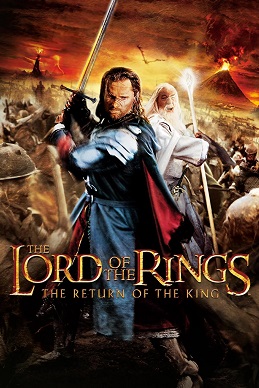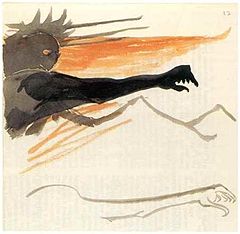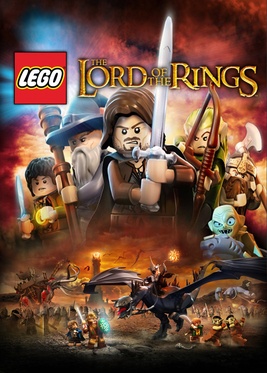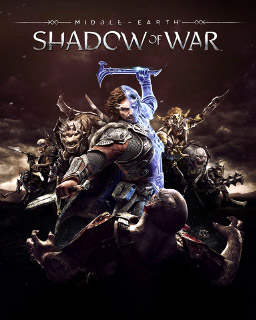
The Legend of Zelda: Four Swords Adventures is an action-adventure game developed and published by Nintendo for the GameCube. It is the eleventh installment in The Legend of Zelda series. It was released in 2004 in Japan on March 18, and in North America on June 7. In 2005, the game was released in Europe on January 7, and in Australia on April 7. The Game Boy Advance handheld game console can be used as a controller when using the GameCube – Game Boy Advance link cable bundled with the game in North America and Europe.

The Lord of the Rings: The Third Age is a 2004 role-playing video game developed by EA Redwood Shores for the PlayStation 2, Xbox and GameCube. A turn-based tactics version of the game was developed for the Game Boy Advance by Griptonite Games. The game was published on all platforms by Electronic Arts, and released worldwide in November 2004.

The Lord of the Rings: The Battle for Middle-earth is a 2004 real-time strategy video game developed by EA Los Angeles for Microsoft Windows. The first part of the Middle-earth strategy game, It is based on Peter Jackson's The Lord of the Rings film trilogy, in turn based on J. R. R. Tolkien's original novel. The game uses short video clips from the movies and a number of the voice actors, including the hobbits and wizards. It uses the SAGE engine. The sequel, The Lord of the Rings: The Battle for Middle-earth II, was released on March 2, 2006.

The Lord of the Rings: The Fellowship of the Ring is a 2002 action-adventure video game developed by WXP for the Xbox. It was ported to the Game Boy Advance by Pocket Studios and the PlayStation 2 and Microsoft Windows by Surreal Software. The game was published by Vivendi Universal Games under their Black Label Games publishing label. In North America, it was released for Xbox and Game Boy Advance in September, and for PlayStation 2 and Windows in October. In Europe, it was released for Xbox, Windows and Game Boy Advance in November, and for PlayStation 2 in December.

The Lord of the Rings: The Battle for Middle-earth II is a 2006 real-time strategy video game developed and published by Electronic Arts. The second part of the Middle-earth strategy game series, it is based on the fantasy novels The Lord of the Rings and The Hobbit by J. R. R. Tolkien and its live-action film series adaptation. It is the sequel to Electronic Arts' 2004 title The Lord of the Rings: The Battle for Middle-earth. Along with the standard edition, a Collector's Edition of the game was released, containing bonus material and a documentary about the game's development.

The Lord of the Rings: The Two Towers is a 2002 action hack and slash video game developed by Stormfront Studios for the PlayStation 2 and Xbox. A 2D Game Boy Advance game of the same name was made by Griptonite Games, a port to the GameCube by Hypnos Entertainment, and to mobile by JAMDAT. A version for Microsoft Windows developed by Ritual Entertainment was cancelled during development. The game was published on all platforms by Electronic Arts. It is an adaption of the 2002 film of the same name. Originally released in North America for the PlayStation 2 in October 2002, it was released in November 2002 for the Game Boy Advance, in December 2002 for the Xbox and GameCube, and in May 2003 for mobile.

The Lord of the Rings: The Return of the King is a 2003 hack and slash action game developed by EA Redwood Shores for the PlayStation 2 and Windows. It was ported to the GameCube and Xbox by Hypnos Entertainment, to the Game Boy Advance by Griptonite Games, to mobile by ImaginEngine, and to Mac OS X by Beenox. The game was published by Electronic Arts. It is the sequel to the 2002 game The Lord of the Rings: The Two Towers.

The Lord of the Rings: War of the Ring is a 2003 real-time strategy game (RTS) developed by Liquid Entertainment and published by Sierra Entertainment, a subsidiary of Vivendi Universal Games. Set in J. R. R. Tolkien’s fictional Middle-earth, it expands upon the events of the War of the Ring as told in his fantasy novel, The Lord of the Rings.

The Lord of the Rings: Conquest is a 2009 action game developed by Pandemic Studios and published by Electronic Arts. It is derived from The Lord of the Rings film trilogy, and borrows many gameplay mechanics from Pandemic's Star Wars: Battlefront games. The game allows the player to play as both the forces of good and evil.

Saruman, also called Saruman the White, later Saruman of Many Colours, is a fictional character of J. R. R. Tolkien's fantasy novel The Lord of the Rings. He is leader of the Istari, wizards sent to Middle-earth in human form by the godlike Valar to challenge Sauron, the main antagonist of the novel, but eventually he desires Sauron's power for himself and tries to take over Middle-earth by force from his base at Isengard. His schemes feature prominently in the second volume, The Two Towers; he appears briefly at the end of the third volume, The Return of the King. His earlier history is summarised in the posthumously published The Silmarillion and Unfinished Tales.

The Lord of the Rings: Aragorn's Quest is an action-adventure video game released in 2010 by WB Games on various Nintendo and Sony platforms, with Headstrong Games developing a Wii version and TT Fusion developing the game on other platforms.
Isildur is a fictional character in J. R. R. Tolkien's Middle-earth, the elder son of Elendil, descended from Elros, the founder of the island Kingdom of Númenor. He fled with his father when the island was drowned, becoming in his turn King of Arnor and Gondor. He cut the Ring from Sauron's hand, but instead of destroying it, was corrupted by its power and claimed it for his own. He was killed by orcs, and the Ring was lost in the River Anduin. This set the stage for the Ring to pass to Gollum and then to Bilbo, as told in The Hobbit; that in turn provided the central theme, the quest to destroy the Ring, for The Lord of the Rings.

In J. R. R. Tolkien's fictional world of Middle-earth, Mordor is the realm and base of the evil Sauron. It lay to the east of Gondor and the great river Anduin, and to the south of Mirkwood. Mount Doom, a volcano in Mordor, was the goal of the Fellowship of the Ring in the quest to destroy the One Ring. Mordor was surrounded by three mountain ranges, to the north, the west, and the south. These both protected the land from invasion and kept those living in Mordor from escaping.

The One Ring, also called the Ruling Ring and Isildur's Bane, is a central plot element in J. R. R. Tolkien's The Lord of the Rings (1954–55). It first appeared in the earlier story The Hobbit (1937) as a magic ring that grants the wearer invisibility. Tolkien changed it into a malevolent Ring of Power and re-wrote parts of The Hobbit to fit in with the expanded narrative. The Lord of the Rings describes the hobbit Frodo Baggins's quest to destroy the Ring and save Middle-earth.

Sauron is the title character and the primary antagonist, through the forging of the One Ring, of J. R. R. Tolkien's The Lord of the Rings, where he rules the land of Mordor and has the ambition of ruling the whole of Middle-earth. In the same work, he is identified as the "Necromancer" of Tolkien's earlier novel The Hobbit. The Silmarillion describes him as the chief lieutenant of the first Dark Lord, Morgoth. Tolkien noted that the Ainur, the "angelic" powers of his constructed myth, "were capable of many degrees of error and failing", but by far the worst was "the absolute Satanic rebellion and evil of Morgoth and his satellite Sauron". Sauron appears most often as "the Eye", as if disembodied.

The Lord of the Rings: War in the North is a 2011 action role-playing hack and slash video game developed by Snowblind Studios and published by Warner Bros. Interactive Entertainment for PlayStation 3, Xbox 360, and Microsoft Windows. An OS X port was developed and published by Feral Interactive in 2013. It is the first video game based on both J. R. R. Tolkien's 1954 high fantasy novel The Lord of the Rings and Peter Jackson's film trilogy adaptation released in 2001, 2002 and 2003. This is because, until 2009, Vivendi Universal Games, in partnership with Tolkien Enterprises, held the rights to make games based on Tolkien's literary works, whilst Electronic Arts held the rights to make games based on the New Line Cinema films. In 2009, WB Games acquired the rights for both intellectual properties.

Lego The Lord of the Rings is a Lego-themed action-adventure video game developed by Traveller's Tales, that was released on Nintendo 3DS, Nintendo DS, PlayStation Vita, Microsoft Windows, Wii, PlayStation 3, and Xbox 360. The OS X version of the game, published by Feral Interactive, was released on 21 February 2013.

Middle-earth: Shadow of Mordor is a 2014 action-adventure video game developed by Monolith Productions and published by Warner Bros. Interactive Entertainment. An original story based on the legendarium created by J. R. R. Tolkien, the game takes place between the events of The Hobbit and The Lord of the Rings film trilogies. The player controls Talion, a Gondorian Ranger who bonds with the wraith of the Elf Lord Celebrimbor, as the two set out to avenge the deaths of their loved ones. Players can engage in melee combat, and use wraith abilities to fight and manipulate enemies. The game introduces the Nemesis System, which allows the artificial intelligence of non-playable characters to remember their prior interactions with Talion and react accordingly in subsequent encounters.

Middle-earth: Shadow of War is a 2017 action-adventure video game developed by Monolith Productions and published by Warner Bros. Interactive Entertainment. Shadow of War is the sequel to 2014's Middle-earth: Shadow of Mordor, both of which are based on J. R. R. Tolkien's legendarium. The game is set in between the events of Peter Jackson's The Hobbit and The Lord of the Rings film trilogies, from which the game also takes inspiration. The player continues the story of Talion, the Gondorian Ranger who bonded with the wraith of the Elf Lord Celebrimbor, as they forge a new Ring of Power to amass an army to fight against Sauron. The game builds upon the "nemesis system" introduced in Shadow of Mordor, allowing Talion to gain followers from several races of Middle-earth and command them in warfare.
Tolkien's monsters are the evil beings, such as Orcs, Trolls, and giant spiders, who oppose and sometimes fight the protagonists in J. R. R. Tolkien's Middle-earth legendarium. Tolkien was an expert on Old English, especially Beowulf, and several of his monsters share aspects of the Beowulf monsters; his Trolls have been likened to Grendel, the Orcs' name harks back to the poem's orcneas, and the dragon Smaug has multiple attributes of the Beowulf dragon. The European medieval tradition of monsters makes them either humanoid but distorted, or like wild beasts, but very large and malevolent; Tolkien follows both traditions, with monsters like Orcs of the first kind and Wargs of the second. Some scholars add Tolkien's immensely powerful Dark Lords Morgoth and Sauron to the list, as monstrous enemies in spirit as well as in body. Scholars have noted that the monsters' evil nature reflects Tolkien's Roman Catholicism, a religion which has a clear conception of good and evil.




















